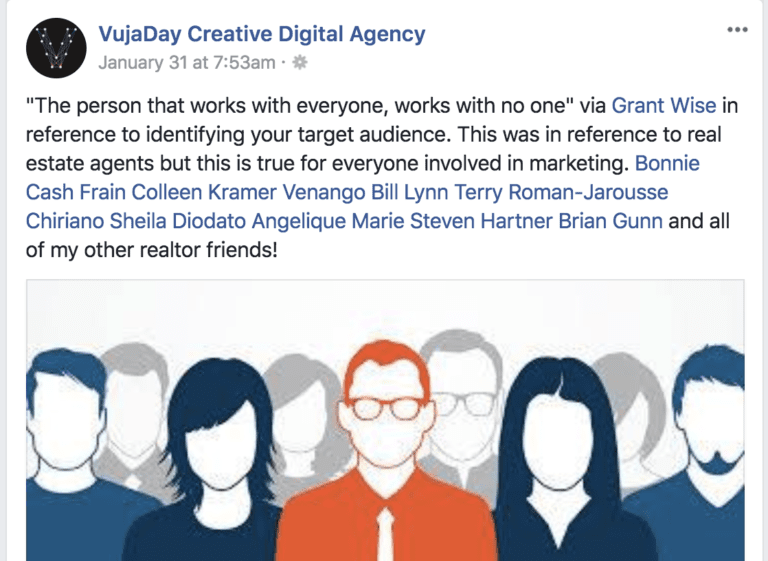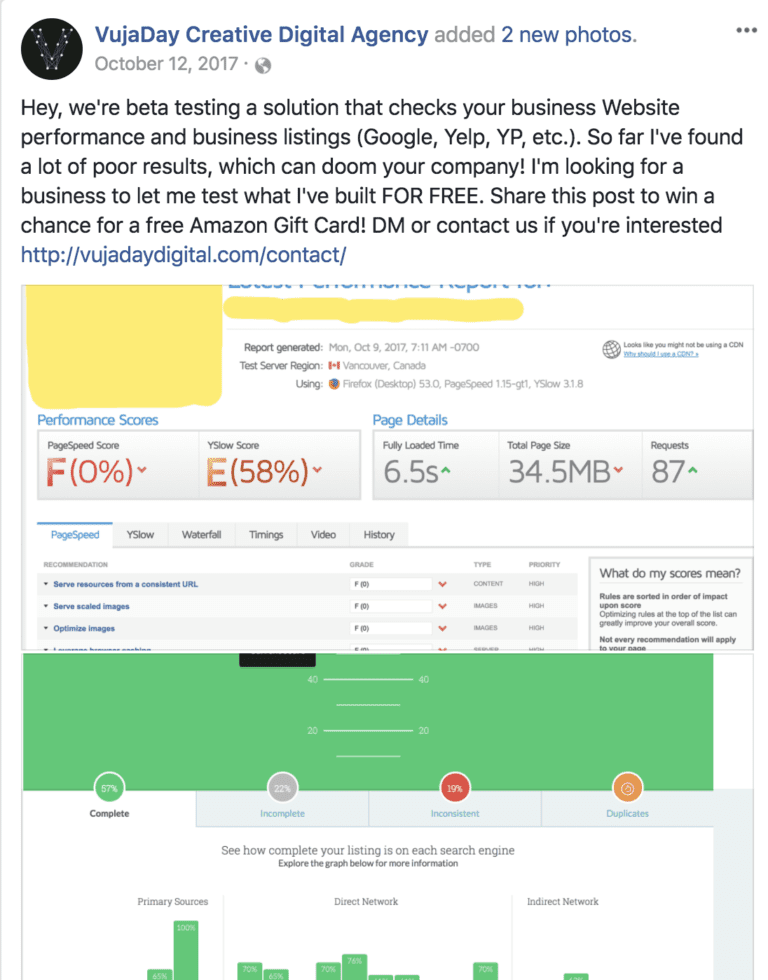Target Marketing
Last week I wrote the blog post I’m a Successful Entrepreneur, Where are my Clients?, which focused on defining your WHY. Why you do what you do, what inspires you to get out of bed in the morning, and how you solve problems better than your competition. The next step is to figure out WHO your WHY resonates with, then target them through a comprehensive target marketing strategy.
A few weeks ago I referenced Doug Wise in a VujaDay Creative Digital Agency organic Facebook post.
A week later, I received an email from Jennifer Yesbeck of Alexa (an Amazon company) that read:
In marketing, there’s a saying, If you’re talking to everybody, you’re not talking to anybody.
The body of the email further stated:
Vague, generic marketing never resonates with audiences in the same way that personal, targeted content can. That’s why targeting in marketing is so important. It helps you:
- Attract and convert high-quality leads
- Differentiate your brand from competitors
- Build deeper customer loyalty
- Improve products and services
- Stay focused
For those of you who have read my past posts, you know that I’m a huge proponent of creative thinking. Accordingly, I have often referenced the creative concept of synchronicity. In my recent blog post VujaDay: Succeed or Die, I attribute the cultivation of my agency to a synchronistic sequence of events. Perhaps the idea of targeting comes to mind because of its prevalence in the world of marketing today, or maybe it’s another synchronistic occurrence that led me to this post.
Marketing can be boring, so I will go with the latter…
At any rate, the aforementioned series of events got me thinking about how business owners are supposed to find customers that are interested in what they are selling as opposed to marketing to everyone.
The answer is target marketing!
From the WHY to the WHO
Once you have defined your WHY, you have to find out WHO that WHY resonates with. If you’re a photographer and your WHY is:
To capture precious experiences that will last a lifetime for families.
The next step would be to identify whose problem this solves, or precisely who it is that would benefit from your services.
This WHO is your target market. Remember, if you’re talking to everybody, you’re not talking to anybody. In the world of marketing, if you don’t identify a specific audience, you’re employing a one-size fits all model with vague messaging that ultimately reaches nobody. Target marketing is the process of deconstructing a large market into smaller, more precise segments within that market. When I started VujaDay Creative Digital Agency, I knew that I wanted to target small business owners because of my experiences with people who had been burned by digital agencies.
The problem was that paradoxically, the small business moniker is a rather large market. Jennifer Yesbeck of Alexa identifies various characteristics that markets are segmented by:
- Demographics: age, gender, education, marital status, race, religion, etc.
- Psychographics: values, beliefs, interests, personality, lifestyle, etc.
- Business Industry: business industry or vertical
- Geographic Areas: neighborhood, area code, city, region, country, etc.
At VujaDay Creative Digital Agency, we utilize various market segment characteristics from above in our digital marketing efforts. First, we identify a niche i.e. photographers, schools, realtors, restaurants/bars, construction companies, doctors, dentists, chiropractors, etc. Then we identify a target location i.e. Philadelphia, Southern N.J., Bucks County, Montgomery County. Next, based on these characteristics we develop user personas. The Interaction Design Foundation offers:
Personas are fictional characters, which you create based upon your research in order to represent the different user types that might use your service, product, site, or brand in a similar way. Creating personas will help you to understand your users’ needs, experiences, behaviours and goals. Creating personas can help you step out of yourself. It can help you to recognise that different people have different needs and expectations, and it can also help you to identify with the user you’re designing for. Personas make the design task at hand less complex, they guide your ideation processes, and they can help you to achieve the goal of creating a good user experience for your target user group.
Below is an example persona for:
Lifestyle Photographers in Southern New Jersey
Bridget
Facts
Bridget lives in a small neighborhood in Southern New Jersey. She is 29, married, has multiple children, and is building a family photography business in her spare time.
Psychographics
Bridget loves photography and spending as much time with her family as possible. She loves going to the Jersey shore and going out to local restaurants/bars with her friends when she is not with her family. She also loves to go to local coffee shops to read, and learn about entrepreneurship and photography.
What matters to Bridget most is family.
Technology Use
Bridget has an iPhone, a high-end digital camera, and uses a MacBook Pro for photo editing. She uses the Internet to do research on building a small business, and photo editing. She utilizes various social media outlets to connect with other small business owners and local photographers, while also using these mediums to share her work as well as for advertising/marketing.
A Day in the Life of Bridget
- Wakes up at 6:30 to eat breakfast and prepares kids for school.
- After the kids go to school, she goes to a local coffee shop for several hours to caffeinate, edit photos, social network, and research small business building.
- Goes home for lunch, and to catch up on work that needs to be done at home.
- Between 1:00 p.m. – 3:00 p.m. she attends scheduled photo sessions.
- By 3:30 p.m., Bridget is home to ensure the kids are home safely and spend time with her husband.
- At 5:00 p.m. the family eats dinner together.
- Three nights a week between 6:00 p.m. – 8:00 p.m., Bridget attends scheduled photo sessions.
- On working nights, she makes sure she is home to put the kids to bed with her husband.
- The nights she is not working, she dedicates evenings to her husband and children.
- In her spare time at night, Bridget works on honing her craft and editing photos.
Future Goals
Bridget plans to build her photography business to include wedding packages. She also wants to take on and train several employees to both scale her business and delegate some of her workload so that she can spend more time with her family.
Scenario Development
After defining the WHY, and WHO, VujaDay develops scenarios where this user persona has a problem that can be solved by our services.
For example: Bridget has been wildly successful with ‘Newborn’ and ‘Engagement’ photo sessions. Until now, word of mouth has been the only marketing funnel required to fill up all of her spare time with photography jobs. However, per Bridget’s future goals, she wants to begin selling wedding photography as a new lucrative package. This is an entirely new market, so she needs more than word of mouth to attract new clients in an extremely competitive local market. Bridget has recently learned that the new Facebook Algorithm will limit her potential organic social media reach, so rather than her posts reaching thousands of friends, they will now reach less than 1% of her page followers (see my recent post Learn How to Use Facebook Marketing Effectively For Your Small Business for more information on the limitations associated with the new rules associated with the Facebook Algorithm).
Based on this obstacle, Bridget is now considering Paid Facebook Ads as a way to market herself to new clients looking for wedding photography in Philadelphia and Southern New Jersey. VujaDay recognizes that for Facebook Ads to be effective, clients have to have a solid digital infrastructure in place to encourage clients to visit their website to either make a purchase, schedule a phone call, or subscribe to an email list. From our experiences, many photographers have either DIY websites or sites that they paid someone a lot of money to deliver a poor product (see this post to learn more about the pitfalls of DIY websites). In a recent marketing campaign where we offered a free digital audit to anybody with a business website, we received over a dozen inquires in less than 24 hours (who doesn’t want something for free?).
NOT ONE of these websites received passing grades for Website Optimization, PageSpeed Scores, or Local SEO Rankings.
After identifying scenarios for the personas, we develop a targeted marketing plan through various funnels including social media.
Stay tuned for next week’s post on how to run a targeted marketing plan through social media!









5 Comments